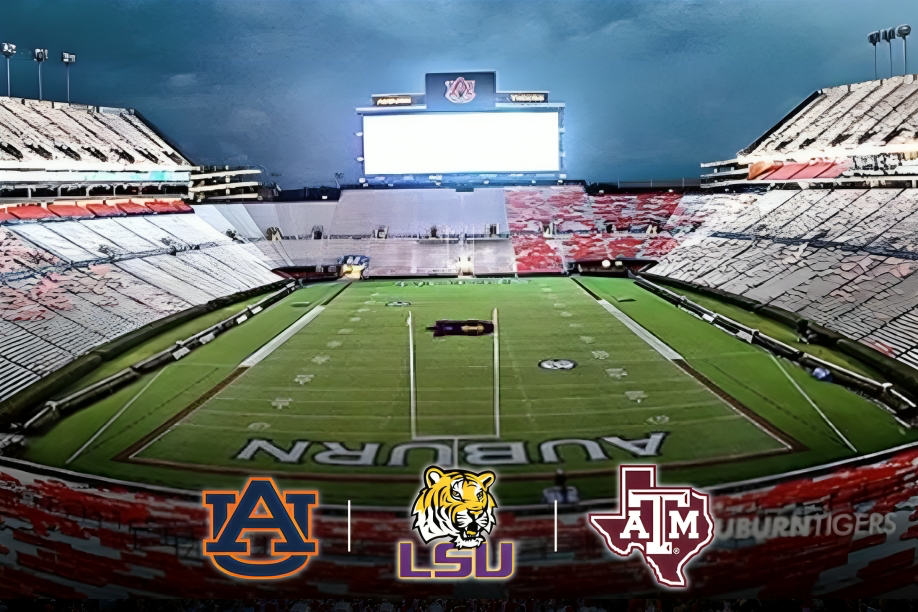

College football used to be all about pride on the field and packed stands echoing with cheers, where the biggest hustle was scoring touchdowns, not chasing dollar signs. Fast forward to 2025, and that story has flipped on its head.
Watch What’s Trending Now!
Since NIL became legal in 2021, college athletes have been cashing checks like pros, with nearly $1.9 billion flowing this year – double last season’s total, which included $853 million from collectives and $150 million in commercial deals. This year, commercial deals are climbing to $290 million, while collective payouts dip $213.4 million. NIL isn’t a side gig anymore, it’s the headline act.
But here’s the real twist: the money isn’t just flowing to the players anymore. College football’s entire business playbook is being flipped. Where are they finding them? Not in the cheap seats.
ADVERTISEMENT
The premium seating revolution
Take Auburn’s Jordan-Hare Stadium. The Tigers aren’t just adding chairs; they’re selling exclusivity:
Locker Room Club: Field-level access, private food and drinks, climate-controlled restrooms
End-zone Field Suites: TVs, canopies, multi-tier rails, dedicated food service
Hall of Fame Club: Indoor seating, refreshments, prime views of the Tiger Walk
ADVERTISEMENT
Auburn is adding over 20 upgrades, pushing capacity just past 88,043, but it’s about quality, not quantity. The future? Fewer flood the stands, more sell the suites.
Top Stories
LIV Golf Braces for Another Possible Exit in Wake of Brooks Koepka Departure

Sean Payton Announces Retirement Plans as Broncos HC Demands Improvement From Bo Nix & Co. Before Playoffs

Greg Biffle’s $4M Prized Possession Goes Up for Sale After Tragic Crash, Leaving NASCAR Fans Heartbroken

Biff Poggi All But Confirms Bryce Underwood’s Michigan Future After Announcing His Own Departure

‘Fighting for His Life’: ESPN Confirms Kirk Herbstreit’s Silent Struggles at College GameDay

Rory McIlroy Makes Feelings Clear on Bryson DeChambeau’s PGA Tour Return: ‘Have Lost…’

The trend is accelerating nationwide:
ADVERTISEMENT
LSU (Tiger Stadium): Field-Level Loge Boxes (close to the action, in-seat service, ADA accessible) and the Stadium Club South (climate-controlled with panoramic views, HD TVs, premium bar)
Texas A&M (Kyle Field): Partnered with Playfly Sports to boost premium hospitality, fan engagement, and NIL opportunities, creating a modern, high-value game-day experience
No old drama!!!
For decades, the formula was straightforward: pack the stadium and watch the money roll in. Big crowds, affordable tickets, and steady concessions made it work.
Now, everything’s flipped. NIL, revenue-sharing, and slipping attendance numbers force programs to rethink the game. It’s no longer about cramming 90,000 fans into bleachers; it’s about squeezing the most revenue out of every single seat. Simply put, schools aren’t chasing every fan anymore; they’re maximizing revenue per seat and creating bigger earning opportunities for players. And the math makes it impossible to ignore.
ADVERTISEMENT
One Auburn example makes the math undeniable: a 20-seat suite priced at $1,000 per ticket nets $20,000 per game. To match that, the school would need to squeeze in 400 fans paying $50 each. Remember when attendance hit a low in 2021, dipping below 40,000 per game, the lowest since 1981, yet revenues continued to climb. Auburn itself saw premium seating revenue jump 15% just last year, and the SEC pulled in an eye-popping $850 million in 2023, thanks to media rights and fancy stadium upgrades.
College football isn’t just about the game anymore; it’s about strategy, big returns, and turning every seat into a premium, revenue-generating asset. But why the sudden race for premium, high-dollar experiences?
ADVERTISEMENT
The reason behind the shift from bleachers to boxes
By 2025, college football hit a turning point. The House v. NCAA settlement opened the door for schools to pay athletes up to $20.5 million a year, and that number is climbing fast. These numbers represent a new financial reality that schools can’t ignore. To meet these rising costs, universities are turning to premium seating options like luxury suites, club seats, and exclusive lounges.
Take Auburn’s Nelson Club: a $1.1 million lifetime donation gets you four seats, but it’s much more than just a ticket. That money goes directly to support athletes and their NIL opportunities. Auburn also runs a $20.5 million revenue-sharing program to help fund the student-athlete experience. Over at LSU, coach Brian Kelly says the 2025 roster costs, “ just about $18 million.. That’s a huge sum, but donors and corporate partners stepping up for multi-year commitments are helping meet it. And as programs see the dollars add up, the race to attract “big spenders” is intensifying.
ADVERTISEMENT
Betting big on big spenders
College football is no longer just about the game. Teams now compete off the field too, turning stadiums into revenue machines. In the so-called “Luxury Arms Race,” schools build premium suites, club seats, and lounges to attract high-paying fans. Like the NFL, 15 to 20 percent of premium attendees can generate nearly half of total stadium revenue, showing that a few wealthy fans can out-earn the rest of the crowd combined. Across the country, programs are doubling down on this trend. LSU is pouring $28 million into expanding premium club seating at Tiger Stadium, providing first-class amenities for fans and corporate partners while generating funds to support athletics and NIL payments.
Texas A&M is adding 23 luxury suites to Kyle Field, boosting its revenue and enhancing fan experiences. Ohio State is introducing new premium suites and chairback seats to elevate both atmosphere and income, and Michigan is exploring ways to expand “The Big House” to maintain its status as a top-tier destination. But it’s not just about the glitter and glamour; premium seating in college football has become a financial necessity. Yet, this strategy comes with drawbacks.
ADVERTISEMENT
The risks of college football’s premium seating boom
College football programs are leaning hard on premium seating to boost revenue:
Ticket prices hit $75 in 2024, up 25% since 2015.
Suites and club seats range from $5,000 to over $100,000 per season.
Even the “Battle at Bristol” in 2016 drew nearly 157,000 fans, proving passion is alive, but passion alone doesn’t pay the bills.
Accessibility is slipping: at Penn State, 21,000 student tickets were cut for the December 2024 College Football Playoff, forcing a lottery for $28 tickets and leaving many fans shut out.
College football mirrors this model, with premium seats bringing in three to four times more revenue per fan, helping programs cover skyrocketing costs and NIL obligations. But the trade-off is real. Lean too heavily on premium seating:
ADVERTISEMENT
Stadiums may look full but feel empty when corporate guests dominate.
Games risk becoming corporate events, pushing loyal fans away.
MLB and NBA examples show revenue booms can shrink fan pipelines, price out casual fans, and disengage younger generations.
When the fans who bleed team colors can’t attend, the roar, traditions, and shared passion fade. But this isn’t unique to the U.S.
Arsenal’s Emirates Stadium is a prime example of how premium seating drives revenue. With around 9,000 luxury suites and club seats, these high-end options generate three to four times more revenue per fan than standard seating. European clubs like Arsenal depend on these affluent customers to stabilize finances, fund player acquisitions, and stay competitive globally. American college football is adopting this model as costs rise, especially with NIL payments and facility upgrades.
What once meant packing 100,000 die-hard fans into the stands now means selling a few thousand premium seats at sky-high prices. The roar of the crowd is giving way to the quiet of catered lounges. College football has stepped off the field and into the boardroom. And the real contest isn’t touchdowns anymore, it’s balancing profits with preserving the soul of the game.
Also Read: The Most Expensive Stadium Built for the Smallest Crowd: Why Less is More at Northwestern
ADVERTISEMENT
ADVERTISEMENT
ADVERTISEMENT

